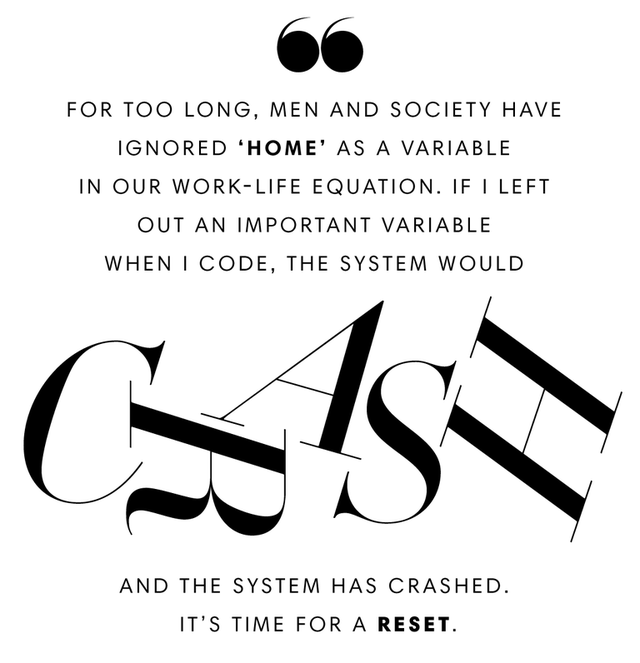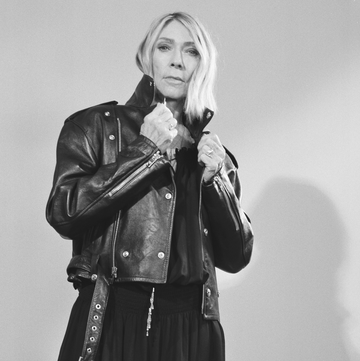“Imagine a giant social experiment where all the undervalued and underpaid women required to get through your day went missing—teachers, housekeepers, babysitters, grandmothers, nannies, home-care aids, you name it—and you and your partner are left to figure it out. Except that ‘experiment’ is reality now.”
I sent that last week to my friend Darcy Lockman, author of All the Rage: Mothers, Fathers, and the Myth of Equal Partnership, who replied: “You should see the text chains from my girlfriends. One expressed gratitude that her husband is ‘helping.’ My least favorite word choice."
Within hours of New York issuing a stay-at-home order, I began receiving texts from women across the country who were going into planning mode.
- Costco or Trader Joe’s? Which do you think is better stocked? Has shorter lines?
- Have you tried finding hand sanitizer, or is it really ALL gone?
- Anyone know the best K-2 reading sites?
Thoughtful questions and advice continued to blow up my phone from friends in opposite-sex relationships. My friend May posted an Instagram Story of a color-coded, hour-by-hour schedule she’d created of her “at-home schoolhouse” that included gardening, sibling teamwork, and random acts of kindness. Her text read, “Let’s do this! #homeschool #femalepower.”
And that’s when it hit me: Just who is behind the let’s in her optimism?
Are Men Texting Their Friends Homeschool Tips?
“Women have been bearing an outsized portion of the domestic workload for a long time, but at least we could share some of that burden with teachers, babysitters, grandmas, and friends. But now that we’ve lost access to that support, those inequities become more stark,” said my friend Darby Saxbe, a professor at the University of Southern California, the director of the USC Center for the Changing Family, and the foremost expert on science behind the gendered division of labor.
Saxbe and Lockman weren't the only ones making these points. Publications like The Guardian and The Atlantic were sounding off with think pieces, like “Women’s Domestic Burden Just Got Heavier with the Coronavirus” and “The Coronavirus Is a Disaster for Feminism,” respectively.
These headlines position COVID-19 as a step back for women. According to Lockman, “Our newish egalitarian values are well and good, but the age-old patriarchal system we live under reinforces an unspoken gender binary in which women are de facto caregivers and men remain emotionally detached. It only follows that mothers are reacting as if the responsibility for halting the spread of COVID-19 within their own small communities and accommodating for their specific household and childcare needs falls solely on them.”
I decided to do my own informal research, posting on Instagram:
During the time of COVID-19, who in your family is responsible for the ‘cognitive’ labor i.e. the conception and planning (ignore execution please) of the following tasks: groceries, laundry, home supplies (hand sanitizer and wipes), emergency planning, meals, cleaning, dishes, friendship and social media (Zoom calls and FaceTime playdates), homework/homeschool, watching (babies, toddlers, school-age kids).
I received more than 100 responses, all with a similar theme: Women are taking on the conception and planning for everything related to homeschooling, managing and preparing food, snacks and screen time, arranging Skype for socialization, organizing supplies, arranging for physical activity, communicating with teachers.
I purposely focused on cognitive labor, because in my research for my book, Fair Play, women reported that the "mental load" (the planning required to execute a given task) is the most time-consuming and burdensome part of domestic work. A recent Harvard study showed that in the best of times, women are the ones doing the cognitive labor for their families. It’s one thing to simply grocery shop and quite another to research what your family needs, budget for supplies, and then hit the store.
9 Ways to Hit the Reset Button
One Google engineer and father said to me, “For too long, men and society have ignored ‘home’ as a variable in our work-life equation. If I left out an important variable when I code, the system would crash. And the system has crashed. It’s time for a reset.” The following 9 suggestions will help.
— 1 —
Make the Invisible Visible
And just like that, no one ever asked a stay-at-home mom what she does all day ever again.
You can’t value what you don’t see right? Visibility = value, and the silver lining of a quarantine is that the full breadth of what women do for our families is more visible than ever.
— 2 —
Believe All Time Is Created Equal
Do you believe an hour holding your child’s hand in the pediatrician’s office is just as valuable to society as an hour in the boardroom? Well, women are as much as 10 times more likely than men to miss work to care for sick children. In fact, women have much less free time overall, as society expects them to use hours outside of work in service of the home. Time is our most precious commodity, and hours spent in service of the home are as worthy as those spent working outside the home. It’s time we invite men to spend their precious hours holding children’s hands too.
— 3 —
Focus on Your Why
Treat this time of social isolation as a gift to take stock, not of toilet paper, but of what you and your partner truly value. My friend Jon who is the primary breadwinner and a successful business owner said to me, “This is a time for us all, and men especially, to rethink our priorities. Start a conversation about what matters most to you. Look up from your screens and be present for your family.”
— 4 —
Make Time for Planning
Feedback in the moment can be toxic. Instead, find a time to talk to your partner when emotions are low and cognition is high. Then you can make intentional choices and clearly define expectations about the division of labor. As a mediator, I encourage my clients to schedule time for regular communication, because you can walk away from an unproductive conversation knowing that there will be another opportunity. Mary O., an educator, said, “Last week, when we realized we'd be working at home and homeschooling our 3- and 5-year-old children, my husband suggested we make our bimonthly meetings nightly.” Saxbe adds, “Couples cope better when they plan ahead. You don’t want to be bickering about who is supposed to set the dinner table when you’re both hungry and cranky.”
— 5 —
Own Tasks From Start to Finish
Everyone at home all day means more. More of everything from chores to working from home to wiping down every surface, again. My informal survey revealed a “dirty dozen”: laundry[E2] , dishes[DJ3] , groceries, meals, home supplies (e.g., hand sanitizer and wipes), emergency planning, tidying up, disciplining/rules for kids, social interactions/managing friendships/kids’ social media kids (Zoom calls and FaceTime playdates), watching kids (babies, toddlers, school-age kids, did your teenager sneak out and break quarantine?), homework/ homeschool (especially for special-needs children), and caring for aging parent.
If your partner is taking on a task, don't offer to help or make a list. Instead, each person should own their task from start to finish. If you are making dinner, pick the menu, cook it, and get it to the table. If you’re both working from home, consider two-to-four hour shifts of “watching” the kids (i.e., brainstorming constructive activities, getting materials ready, and carrying out the plan).
— 6 —
Focus on Fairness, Not 50/50
My fair is not your fair. There is no one way to do a pandemic. What I do know is that in my research for Fair Play when women felt relieved of the conception and planning as opposed to just execution of tasks, they reported that the division of labor in their home was more equitable and fair even when it wasn’t 50/50 down the middle.
— 7 —
Modeling Matters (Including Out of Office Responses)
One woman I reached out to said to me, “I realize even if I am okay doing it all, I am not okay with my daughter and son watching me do it all.” Treat this moment as an opportunity to model fairness for the next generation, your colleagues, and your community.
I did a silent cheer when I saw the auto-response of a colleague last week: Amid the coronavirus crisis, my husband and I are sharing childcare responsibilities. Please pardon delays in my replies and outside business hour emails. I will be online, working 6-11 am ET and 6-9 pm ET.
“Kids can distinguish between genders as early as 18 months old, and use their knowledge about which group they themselves belong to in order to model their own behavior. And to put a bit of pressure on the dads out there, research with older kids, both male and female, shows that it’s their fathers’ attitudes about marital roles—and not their mothers’—that get internalized,” said Lockman.
— 8 —
Burn Guilt and Shame
“When women can't keep up with doing it all, because they're human, they end up feeling guilt and shame, ” added Dr. Pooja Lakshmin, MD is a psychiatrist specializing in women's mental health and a clinical assistant professor at George Washington University School of Medicine. Before I went on my book tour in October, I found a piece of my daughter’s origami paper and a silver Sharpie; I wrote guilt and shame on it in cursive. I then folded the paper into a tiny square and lit it with a match. As the paper burned, I spoke to guilt and shame: “Thank you for being in my life. You have helped me along my journey, but I won’t let you hold me back any longer.” Try it. It works.
— 9 —
Be a Cultural Warrior (Care About Care)
If your partner is already stepping up, don’t dismiss the issue with a “this doesn’t apply to me and my partner." Sociologist C. Wright Mills famously said, “Private troubles. Public issues.” Even if it’s not unbalanced in your particular home, the presumption that mothers and not fathers are the primary caretakers, affects all women, and single mothers feel it the worst.
“A growing body of research shows that the gender wage gap is really a motherhood gap. Women without children earn just about as much as men. The thinking goes, employers expect women with kids to be less available, and they don’t expect men with kids to be less available, and thus they pay them accordingly. Until that shifts, even mothers with equal partners at home are going to continue to take a wage hit,” Lockman says.
Sunlight is the greatest disinfectant. If we can use this extraordinary, unexpected social experiment to shine light on the gender imbalance in housework and childcare, and bring greater fairness to our partnerships, true work-life integration for both women and men won’t be seen as a nice-to-have but a must-have. The new normal is not to pretend and hide the fact that we have families, it’s to celebrate the value of care and caregiving in all its chaos and glory.
Eve Rodsky’s Fair Play: A Game-Changing Solution for When You Have Too Much to Do (and More Life to Live) is available now.

Eve Rodsky is the New York Times bestselling author of Fair Play and Find Your Unicorn Space: Reclaim Your Creative Life in a Too-Busy World.















